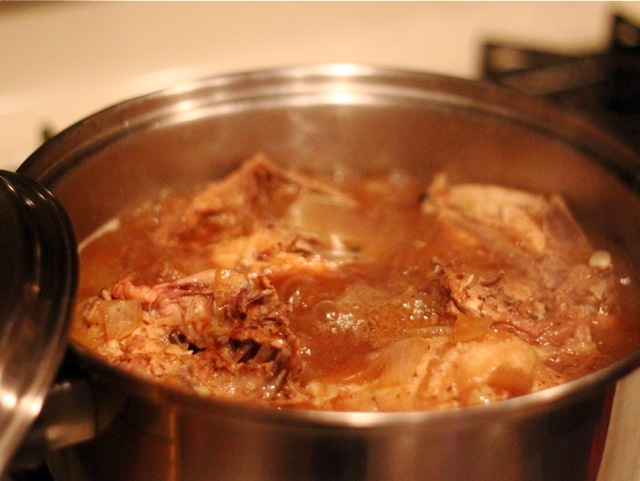
reference-image, l
(article, Keith Wagstaff)
[%pageBreakSettings nobreak=true] [%adInjectionSettings noInject=true] Asking a Filipino mother for her adobo recipe is like asking an Italian mamma for her pasta measurements: you're met with blank stares. Neither one uses a written recipe. Instead, they each rely on an innate sense of how the dish is put together, formed as result of eating (and then making) the dish over and over again for years. Adobo is perhaps the Philippines’ most popular dish, consisting of pork and/or chicken cooked in a pungent mix of vinegar and soy sauce. Don’t confuse it with the many other variations of adobo (a Spanish term that loosely translates into “marinade” or “dressing”), which range from a thick, chipotle-infused sauce in Mexico to a garlicky dry rub in the Caribbean. In the Philippines, adobo is by far the most popular dish, consisting of pork and/or chicken cooked in a pungent mix of vinegar and soy sauce. I’ve been eating it my entire life. [[block(sidebar). h1.Featured recipe]] As a kid, I remember liking the sauce more than anything else, spooning the garlic-flecked mixture carefully over a pile of warm rice. Thanks to considerable amounts of vinegar, the sauce is addictively tangy. (The use of vinegar dates back to the days before refrigeration; in the tropical climate of the Philippines, vinegar helped preserve meat. Filipinos cut the acidity of vinegar with herbs and other ingredients.) My mother, Imelda Wagstaff, ate adobo at least once a month when she was growing up in the Philippines. One night, while escaping a cold New York winter with a lengthy stay at my parents’ house in balmy southern California, I asked her if she could make it for me. |[%image keithsmom width=300 caption="The author's mom, Imelda Wagstaff, prepping adobo in her kitchen."]|[%image adobomeat width=300 caption="Chicken and pork on the chopping block."]| Writing down her recipe was difficult, to say the least. I don’t think I’ve ever seen my mom use a measuring cup. This time, however, she said she would try. We carefully tracked just how much of each ingredient she used, depending on her eyes and nose to judge if it was the right amount. In the end, the dish came out as it always does: hearty, savory, and tremendously comforting. Of course, the version of adobo I grew up with is by no means the standard. That's because a standard adobo simply doesn't exist. In every Filipino kitchen, whether at a restaurant or in a home, you’ll probably find a different version of adobo: one with a thick, pungent sauce, another cooked with sweet coconut milk, a third pull-apart soft, a fourth crisped brown around the edges. I tend to cook the version my mom makes, with a soupy sauce easily spread over rice and tender meat browned gently in a frying pan before consumption. My parents’ house is and always has been a very welcoming place, partly because my mother wanted to keep tabs on me as a teenager and partly because both of my parents are extremely sociable people. I always had friends over, and leftover adobo was fair game after a long night of video games. |[%image adobopot width=300 caption="The pot of simmering adobo."]|[%image reference-image width=300 caption="The finished dish, served over rice."]| Many Filipino dishes are, ahem, acquired tastes. Although I love kare-kare (oxtail braised in peanut sauce) and sizzling sisig (various chopped pig parts topped with lemon juice and an egg), many non-Filipinos find them odd, which is why the mild yet complex adobo was the preferred dish among my visiting friends. Not that my mom has learned to cook for fewer people since my siblings and I moved out. When preparing the dish for me that winter night, I asked her how much of the chicken she'd bought we should use for the recipe. The answer, of course, was all of it — four pounds of chicken. Plus a pound of pork shoulder. I have no doubt that she uses the same amount when cooking for just her and my dad. I’ve inherited the same tendency, cooking giant pots of adobo or arroz caldo (a gingery rice porridge) ample for a family of five, then eating it nonstop for a week or two. That’s actually the beauty of adobo: it tastes almost as good reheated over fresh rice as it does when you first cook it. As a kid, I used to get tired of it, eating adobo for a straight week. These days, I wish I had the time to cook it more often. p(bio). Keith Wagstaff is a food writer living in New York City. His work has appeared in such publications as the Village Voice, Time Out New York, Wine Enthusiast, The L Magazine, and the Huffington Post.

reference-image, l

adobopot, l

adobomeat, l

keithsmom, l

newsletter-image, l